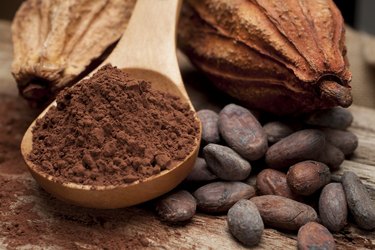
Aside from often being more affordable than artisan or high-end chocolate bars, baking chocolate is found in a different part of the supermarket and distinguishes itself as a treat that's meant to add flavor rather than to eat out of hand. That's not always true, since baking chocolate can be quite tasty by itself, but it does have a few notable differences from bar chocolate.
For Baking
Video of the Day

Baking chocolate is marketed as such because it's almost always unsweetened. According to Ghirardelli, a baking bar is most often 100 percent cacao, which means it has no added sugar and a naturally bitter taste. As such, it's not always ideal for eating out of hand, but in recipes that do have added sugar, it will lend a rich, chocolate flavor. Baking chocolate can also be trusted to melt down uniformly, since it contains few additional ingredients other than cacao. While you can certainly bake with chocolate bars, they will add extra sweetness to a recipe.
Video of the Day
For Eating

There is some flavor variation among varieties of baking chocolate, especially since not every type is unsweetened. For example, semisweet baking chocolate tastes a lot like chocolate chips, and if you enjoy eating those plain, you'll likely enjoy the chocolate in baking form as well. However, since bar chocolate typically contains a variety of ingredients that make it more palatable -- such as sugar, vanilla and milk solids -- it's best for eating plain.
Nutrition Facts
According to the United States Department of Agriculture, 100 g of baking chocolate has about 500 calories, 13 g protein, 52 g fat (32 g of which are saturated), 30 g carbohydrates, 16.5 g fiber, no cholesterol and just 1 g sugar. In contrast, 100 g of a milk chocolate candy bar has about 550 calories, 7.5 g protein, 32.5 g fat (22.5 g of which are saturated), 55 g carbohydrates, 2.5 g fiber and a whopping 52 g sugar.
Considerations

Both baking chocolate and chocolate bars have the same core ingredient -- cacao -- and similarities in taste, so when you're considering which one to use let your purpose dictate the choice. A pan of brownies has a hefty amount of added sugar and could benefit from the pure chocolate flavor that unsweetened baking chocolate would add, but a better option for an after-dinner snack might be a sweetened bar infused with dried fruit or a flavor extract.